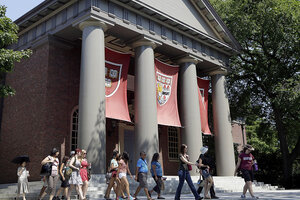How the government spends more per student at elite private universities than public
Private university endowments are now around $550 billion, centered in a handful of prestigious institutions. Public universities, by contrast, have little or no endowment income. They get almost all their funding from state governments, and those subsidies have been shrinking.

People are led on a tour group at the campus of Harvard University in Cambridge, Mass. Reich argues that by way of tax deductible contributions from wealthy donors, the federal government spends more on students at elite private colleges like Harvard than it does on students at public universities.
Elise Amendola/AP/File
Imagine a system of college education supported by high and growing government spending on elite private universities that mainly educate children of the wealthy and upper-middle class, and low and declining government spending on public universities that educate large numbers of children from the working class and the poor.
You can stop imagining. That’s the American system right now.
Government subsidies to elite private universities take the form of tax deductions for people who make charitable contributions to them. In economic terms a tax deduction is the same as government spending. It has to be made up by other taxpayers.
These tax subsidies are on the rise because in recent years a relatively few very rich people have had far more money than they can possibly spend or even give away to their children. So they’re donating it to causes they believe in, such as the elite private universities that educated them or that they want their children to attend.
Private university endowments are now around $550 billion, centered in a handful of prestigious institutions. Harvard’s endowment is over $32 billion, followed by Yale at $20.8 billion, Stanford at $18.6 billion, and Princeton at $18.2 billion.
Each of these endowments increased last year by more than $1 billion, and these universities are actively seeking additional support. Last year Harvard launched a capital campaign for another $6.5 billion.
Because of the charitable tax deduction, the amount of government subsidy to these institutions in the form of tax deductions is about one out of every three dollars contributed.
A few years back, Meg Whitman, now CEO of Hewlett-Packard, contributed $30 million to Princeton. In return she received a tax break estimated to be around $10 million.
In effect, Princeton received $20 million from Whitman and $10 million from the U.S. Treasury – that is, from you and me and other taxpayers who made up the difference.
Add in these endowments’ exemptions from taxes on capital gains and on income they earn, and the total government expenditures is even larger.
Divide by the relatively small number of students attending these institutions, and the amount of subsidy per student is huge.
The annual government subsidy to Princeton University, for example, is about $54,000 per student, according to an estimate by economist Richard Vedder. Other elite privates aren’t far behind.
Public universities, by contrast, have little or no endowment income. They get almost all their funding from state governments. But these subsidies have been shrinking.
State and local financing for public higher education came to about$76 billion last year, nearly 10 percent less than a decade before.
Since more students attend public universities now than ten years ago, that decline represents a 30 percent drop per student.
That means the average annual government subsidy per student at a public university comes to less than $4,000, about one-tenth the per student government subsidy at the elite privates.
What justifies so much government spending per student in private elite universities relative to public ones?
It’s not that the private elites educate more children from poor families. One way to know is to look at the percentage of their students receiving Pell Grants, which are available only to children from poor families. (The grants themselves are relatively modest, paying a maximum of $5,645.)
In fact, the elite privates with large endowments educate a smaller percentage of poor students than universities with little or no endowment income.
According to a survey by the National Association of College and University Business Officers, only 16 percent of students in highly-endowed private universities receive Pell Grants, on average, compared with 59 percent at the lowest-endowed institutions.
At Harvard, 11 percent of students receive Pell Grants; at Yale, it’s 14 percent; Princeton, 12 percent; Stanford, 17 percent.
By contrast, 59 percent of students at the University of Texas in El Paso receive Pell grants, 53 percent at the University of California at Riverside, and 33 percent at the University of California at Berkeley.
Moreover, because public universities have many more students than elite private universities, their larger percentages of Pell students represent far greater numbers of students from poor families.
For example, the University of California at Berkeley has more Pell eligible students than the entire Ivy League put together.
But perhaps the far higher per-student subsidies received by elite private universities are justified because they’re training more future leaders who will be in a position to reduce the nation’s widening inequality.
Unfortunately, there’s not much evidence for that proposition. According to a study by sociologist Lauren Rivera, 70 percent of Harvard’s senior class submits résumés to Wall Street and consulting firms. In 2007, before the global financial meltdown, almost 50 percent of Harvard seniors (58 percent of the men, 43 percent of the women) took jobs on Wall Street.
Among Harvard seniors who got jobs last spring, 3.5 percent were headed to government and politics, 5 percent to health-related fields, and 8.8 percent to any form of public service. The percentages at the other Ivies are not much larger.
So what justifies the high per-student government subsidies at the elite private universities, and the low per-student subsidies in public universities?
There is no justification.

